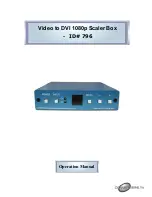
The green LED illuminates when composite video is selected.
The Yellow LED illuminates when S-Video is selected.
2. Input select button:
Press the button to select your desired input source between composite
video and S- Video.
3. IR Sensor:
Infrared remote control sensor.
4. Menu/Enter:
This button serves two purposes.
a. Press the button to bring up OSD main control menu as shown in the
"OSD Operation".
b. To act as a "enter" key to enter sub menu of you selected item or adjust
value of the selected item.
5/6. +/- button:
Press the button to move up or down the tick "V" to your
desired parameter. Or after a parameter is selected by pressing
MENU/ENTER button,
press the button to alter the value of your selected parameter.
Rear Panel
1. DC power jack:
5V 2A DC power input.
2. Composite Video:
Use a Composite video cable to connect the
composite video output of the source equipment to this composite
video(CV) input of the scaler.
3. S-Video:
Use a S-Video cable to connect the S-Video output of the
source video equipment to this " S-Video" input on the back of the video
scaler.
S-Video provides improved performance over composite video and is
recommended over composite.
4. DVI output:
The Video to DVI Scaler Box can output a variety of PC and
HDTV progressive resolutions, in both digital and analog format through DVI-
I connector.
Digital output:
Connect Video to DVI Scaler Box's digital DVI output to the
DVI input of your TV/display unit using a DVI to DVI cable .
Analog output:
If you are to use Video to DVI Scaler Box's analog output to
connect to the analog input of your PC or HDTV, you need to use a DVI to
VGA adaptor to pull out analog signal from the DVI-I connector . The DVI to
VGA adaptor is then connect to the VGA input of your display monitor
through a VGA cable if output is PC resolution, or connect to the YPbPr
input of your HDTV through a VGA to YPbPr/3 RCA adaptor cable if output
is HDTV resolution.
Note: DVI to VGA adaptor is not included in the standard package,
and has to order separately.

























